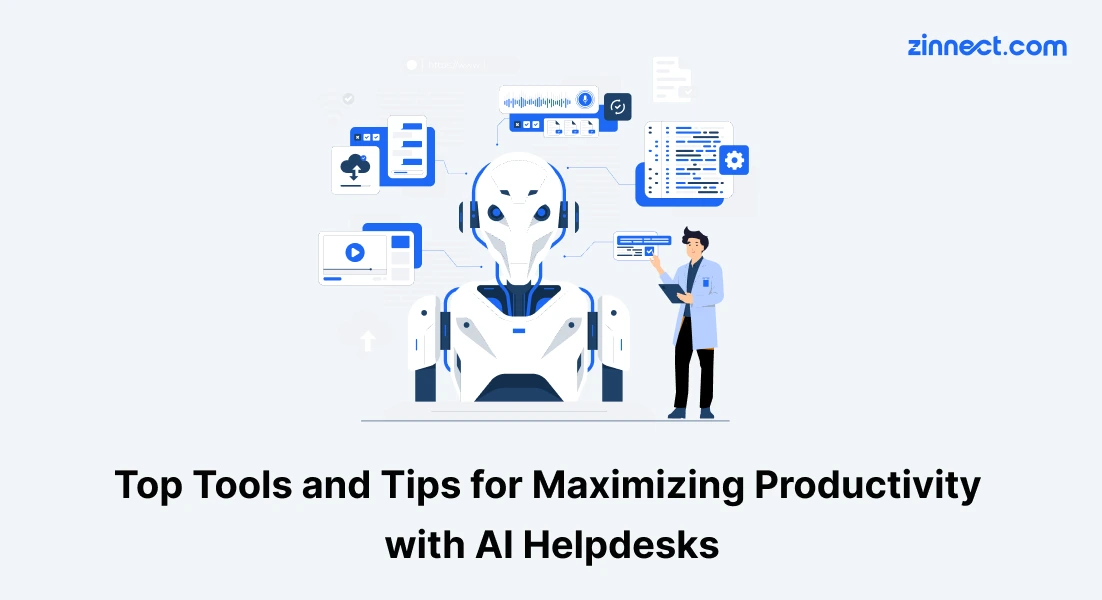Top Tools and Tips for Maximizing Productivity with AI Helpdesks

Customer support excellence doesn’t come from wishful thinking or one-off wins, it’s built through repeatable systems, solid habits, and unwavering focus. A high-performing support team is never a fluke.
But even the strongest systems can face strain.
When ticket volumes surge, issues grow more complex, and hiring can’t keep pace, cracks begin to show. That’s when AI productivity tools step in, not just to automate, but to remove the mental weight of repetitive tasks. By doing so, they free agents to focus on what truly matters: solving creatively, listening empathetically, and driving real value in every customer interaction.

“You do not rise to the level of your goals. You fall to the level of your systems.”
What ‘Productivity’ Actually Means in Helpdesks
When you hear “productivity,” you might picture faster response times or more tickets closed per hour. That’s part of it. Real helpdesk productivity is about letting agents:
- Solve smarter, not harder: Repetitive queries shouldn’t demand repetitive effort. AI-powered systems can suggest accurate, personalized responses in seconds, saving agents from typing the same resolution ten times a day. This frees them up to apply their expertise where it really counts: in complex or sensitive cases that require human insight.
- Prioritize effectively: Not every ticket needs immediate attention, and not every issue has the same weight. Smart routing and triage systems help agents see, at a glance, which tickets are urgent, high-impact, or time-sensitive. Instead of reacting to whatever pops up next, they respond strategically.
- Operate with intent: When agents spend their day putting out fires, it’s hard to think long-term. Real productivity tools reduce the noise, fewer distractions, clearer workflows, and intelligent support surfaces that guide agents toward meaningful engagement. The result? Less burnout, more satisfaction, and a more thoughtful approach to support.
Support efficiency isn’t just about speed, it’s about making every ticket count.
Here’s a look at three common bottlenecks and how AI helpdesk tools transform them:
- Template Fatigue: Agents spending 40% of their shift rewriting FAQ answers? AI can draft these replies instantly.
- Routing Confusion: Misrouted tickets are costly. AI-powered triage routes based on content and sentiment, cutting misassignment in half.
- Channel Overload: Support spreads across email, chat, and social platforms. A unified AI ticketing system centralizes conversations in one workspace.
These three changes add focus, clarity, and speed, without sacrificing quality.
Zinnect’s Approach: Productivity That Feels Intentional
Zinnect doesn’t just offer features, it embodies a philosophy. Here’s how Zinnect aligns with modern helpdesk values:
Unified Inbox Across Channels
All messages from email, chat, and social are pulled into one place. This enables support efficiency and ensures no message is missed.
AI-Powered Ticket Categorization and Prioritization
Using intent detection, tags, and sentiment analysis, Zinnect ensures tickets are triaged correctly at inception. This powerful facet of a workflow automation AI helpdesk frees agents from manual classification.
Drafted Responses, Not Dictated
The AI assistant generates reply suggestions, complete with context. Agents stay in command, refining and personalizing each message—ensuring the AI supports, not replaces.
Smart Automations, Not Busywork
Easily set triggers for routine tasks, like sending follow-ups or closing resolved tickets. No fluff, no technical overhead, just impactful AI helpdesk tips baked into daily workflows.
Actionable Insights on Performance
Every automated or human interaction generates insight. Zinnect surfaces ticket trends, response gaps, and sentiment alerts, turning support into an adaptable, data-informed function.
Security Built into the Core
Data privacy isn’t an afterthought. Zinnect complies with enterprise-grade standards, ensuring sensitive customer information is handled with care.
A friendly reminder on Zinnect’s own tagline: “Your workday could be 10x productive when AI assists in everything you do.” That ethos informs every tool and workflow.
Designing a Smarter Work Day with AI
Here’s how to structure your support teams’ day to maximize impact:
Morning Kickoff
The AI highlights new tickets with urgency or sentiment flags. Agents spend 10 minutes reviewing instead of 30.
Midday Workflow
While agents tackle complex issues, AI handles routing, follow-up emails, and low-touch fixes. Each ticket is neatly labeled, and each agent’s load is balanced.
End-of-Day Wrap-Up
The system automatically escalates tickets with no action, sends summaries, flags hot issues, and suggests teammate handoffs, no need for agents to stay late.
The result is more than smoother shifts or quicker resolutions. It’s a work environment where clarity replaces chaos, collaboration feels intuitive, and burnout has less room to grow. Over time, this shift doesn’t just improve productivity, it elevates team morale, customer experience, and the overall quality of service.
When AI quietly powers the background, your people can step confidently into the foreground, where they actually belong.
Smarter Systems Without the Jargon
Here are five AI helpdesk tools you’ll want in your stack, no brand names, just what they do:
AI-Powered Inbox Triage
A system that reads and categorizes tickets across platforms, email, chat, social, based on urgency and topic. No overload, no overwhelm.
Contextual Reply Assistant
Drafts message suggestions based on ticket history, user data, and tone. Keep your voice, save time.
Automated Workflow Trigger
Run follow-up actions, status updates, notifications, or escalations, based on pre-defined ticket states. The system does the work, you guide it.
Sentiment Monitor and Alert
Detect tickets with negative emotional signals, alert agents immediately. Better coverage for frustrated or crucial interactions.
Insight Dashboard
Delivers analytics on response times, ticket deflection, and agent workload. Identifies underperforming flows and training gaps.
A productivity-focused helpdesk brings these five systems together in a cohesive, support efficiency‑boosting whole.
Practical Tips for AI Adoption
By piloting thoughtfully, keeping humans in the loop, and staying close to real-time feedback, you’re not just introducing new tech, you’re reshaping habits and redefining what productivity looks like. Over time, these small adjustments lay the foundation for lasting impact, where both agents and customers benefit from smarter, more human-centered support.
Use this checklist to ensure smooth setup and results:
| Focus Area | What to Do | Why It Helps |
|---|---|---|
| Pilot with Purpose | Automate one workflow (like password resets or triage) | Gains early wins and builds momentum |
| Agent-First Training | Show how AI tools reduce effort, not replace agents | Builds trust and drives adoption |
| Iterate Based on Data | Regularly review sentiment trends and bottlenecks | Keeps workflows relevant and efficient |
| Schedule Consistency Checks | Assign an owner to review automations weekly | Keeps processes in shape |
| Human Fallback Path | Always include “talk to a human” options | Protects customer trust and avoids frustration |
A simple, structured rollout ensures your AI helpdesk tips become lasting habits, not hidden features. Adopting AI in your helpdesk shouldn’t feel like a leap of faith, it should feel like a series of well-informed, intentional steps. A simple, structured rollout like this ensures that AI tools don’t get buried as background features or add-ons. Instead, they become a natural extension of how your team works.
If AI Isn’t Working For You, Ask These Questions
- Not getting the ROI you expected?
- Is your data messy or fragmented? AI needs clean inputs to perform.
- Are agents bypassing the assistant and doing manual work?
- Is automation too aggressive, causing customers to backtrack?
- Is sentiment ignored because reporting is buried or unclear?
If you answered “yes” to any of these, it doesn’t mean AI has failed — it means your setup needs a tune-up. AI is only as strong as the systems and behaviors around it. When it’s not integrated thoughtfully, it can create more work instead of less, confuse rather than clarify, and risk undermining both agent trust and customer experience.
The good news? Every one of these issues is fixable. Whether it’s cleaning up data inputs, re-aligning agent workflows, or adjusting the balance between automation and empathy, small shifts can restore AI’s purpose: to make support smarter, not faster at making mistakes. Now let’s move on to understanding the value of intentional investment in AI.
The Value of Intentional AI Investment
Cut repetitive tasks by up to 50%
Routine actions like answering common queries, sending follow-up emails, or logging ticket details can eat up a huge portion of an agent’s day. With AI automating these low-impact tasks, agents save hours each week, freeing them to focus on more complex, rewarding work that truly requires human judgment.
Reduce routing errors by 70%
Tickets that land in the wrong queue or go unnoticed delay resolution and frustrate both agents and customers. AI tools equipped with intent detection and sentiment analysis can triage tickets accurately based on urgency, topic, or complexity, ensuring they reach the right person the first time.
Boost first response scores by 20%
Speed matters, especially in first impressions. AI can instantly acknowledge incoming requests with personalized responses or suggested solutions, shortening the response window significantly. This not only improves metrics but reassures customers that their issues are being handled with urgency and care.
Raise customer satisfaction consistently, even with lean operations
With smarter workflows, balanced agent workloads, and faster resolutions, customer experience naturally improves, without requiring large team expansions. AI allows support teams to scale their impact, delivering consistent service quality even when resources are tight or volumes spike.
Final Thoughts: Reclaim Time. Regain Focus. Reignite Support.
Productivity in support isn’t just about faster responses or higher ticket counts. It’s about enabling your team to do the work that truly matters. When AI takes over the repetitive, low-impact tasks, your agents gain the freedom to focus on complex problems, build stronger customer relationships, and find real purpose in their role.
Start small: adopt one intelligent tool, build confidence, and scale mindfully. The result is a high-performing helpdesk that blends efficiency with empathy and delivers lasting impact.
To get a deeper understanding of how AI tools help maximize productivity, give our detailed guide a read.
Ready to see what smarter support looks like? Visit to learn how AI can transform your helpdesk.
Frequently Asked Questions
An AI helpdesk tool uses machine learning to automate ticket triaging, draft replies, and improve response times while reducing manual workload.
They streamline repetitive tasks, prioritize tickets intelligently, and surface insights. This helps agents focus on solving real issues and not just sorting them.
No. The best AI systems are designed to support agents, not replace them, by handling routine tasks and surfacing relevant context.
Look for unified inboxes, smart categorization, contextual reply suggestions, automated workflows, and real-time analytics.
Zinnect unifies conversations, drafts helpful responses, automates routine actions, and delivers insights, all while keeping agents in control.